
UC Davis Students Fuse Art and Science to Create Wall Mural at Raptor Center
UC Davis Distinguished Professor Diane Ullman and Lecturer Emerita Gale Okumura Lead Project
Quick Summary
- 'A Bird's Eye View' Showcases Raptors and the Insects They Eat
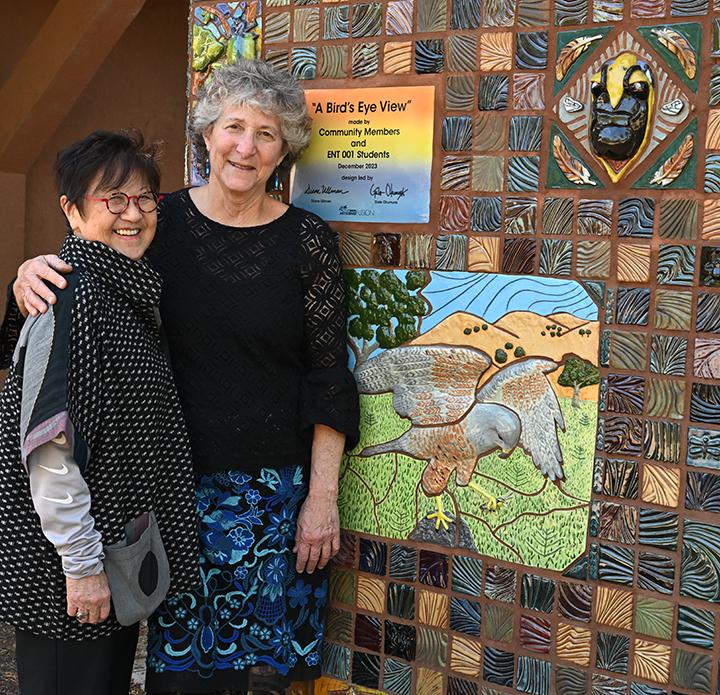
It's massive. It's majestic. It's memorable.
“A Bird's Eye View,” a large-scale, ceramic-mosaic mural that graces an outer wall of the California Raptor Center (CRC) museum at the University of California, Davis, tells the story of the interdependence of raptors and insects, ranging from a golden eagle, great-horned owl and a red-tailed hawk to a clear-winged grasshopper, fiery skipper butterfly and figeater beetle.
The mural is primarily the work of 80 UC Davis students in Entomology 001, “Art, Science and the World of Insects,” taught by UC Davis distinguished professor-artist Diane Ullman of the Department of Entomology and Nematology. Ullman and colleague Gale Okumura, a Department of Design emerita lecturer, led the project. Other faculty, CRC volunteers and staff, and members of the community, also contributed to the 3000-hour project.
Measuring 22-feet wide and 8-feet in height, the mural is comprised of more than 1300 handmade ceramic relief artworks, tiles and trim pieces, commands both awe and attention on the museum wall.
“The mural celebrates 11 key raptor species found in California and 84 insect species that are either parasites of these raptors or eaten by them,” said Ullman, a UC Davis doctoral alumna and entomologist-artist a member of the UC Davis entomology faculty since 1994. “The interdependence of birds and insects is striking in food chains around the globe. As insects decline, bird populations are also damaged. When birds decline, some insect populations surge and can rise to damaging levels.”
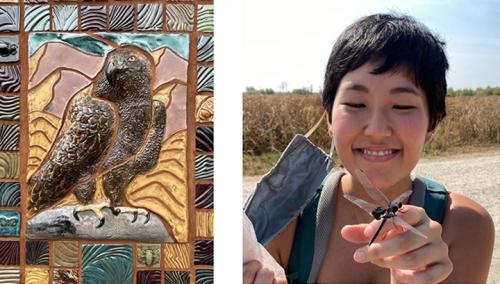
The project features two great-horned owls by Ullman; a prairie falcon and a Cooper's hawk by Okumura; an American kestrel by Sarah Rizzo; a red-tailed hawk by Mary Foe; Swainson's hawk by Teresa Slack; northern harrier by Stacey Larson; a screech owl by Kirsten Sheehy; burrowing owls by Valerie Jones; a golden eagle by Hee Jin Chung; elf owls by Adele Zhang, and a hummingbird by Susan Dileanis and Lisa Tell.
“Hummingbirds are sometimes consumed by raptors,” Ullman noted.
The California Raptor Center (CRC) is a UC Davis School of Veterinary Medicine educational and research facility dedicated to the rehabilitation of injured and orphaned birds of prey (raptors), according to Julie Cotton, CRC co-manager of operations. The center, authorized by the California Department of Fish and Wildlife and the U.S. Fish and Wildlife Service, takes in 100 to 200 sick, injured, and orphaned raptors each year, successfully returning about 60 percent to the wild.

“I love the mural!” said William Thein, CRC co-manager of operations. “Julie and I have been trying to beautify the Raptor Center since we started working here and this mural is an exceptional example of what we are trying to accomplish with the tour route. I have to say the Harrier is my favorite but I see something new every time I look at it. All the feather lice and insects that the birds regularly prey on are really cool to talk about when visitors ask about the mural. I think a lot of people don't realize how much raptors eat insects.”
Ullman says she hopes that those viewing the mural will “learn about this delicate balance and are inspired to protect our environment, our raptors and yes, our insect populations.”
Ullman credits Cotton, Thein, and UC Davis student Tiffany Varcados “for making this mural possible,” and to multimedia artist Amanda Larson of the Bay Area “who brought her expertise to its installation.”

Student artist Genevieve Burye, a fourth-year civil and environmental engineering double major, stopped by the Raptor Center during the 13th annual UC Davis Biodiversity Museum Day to show her twin sister her work. “Diane Ullman is so helpful to us students,” she said. “She is an amazing person who does incredible work.”
Burye created a tile focusing on the moth Furcula cinereoides, better known as the American puss moth. “While working on my tile, I learned the American puss moth is eaten by flammulated owls which surprised me since I never knew owls ate insects. I decided to emphasize the life cycle of F. cinereoides in my piece since it undergoes complete metamorphosis.
“I used clay and underglazes to make poplar leaves, the puss moth caterpillar's favorite, as well as the eggs, caterpillar, and moth,” Burye shared on a PowerPoint presentation that the coordinators assembled. “While the caterpillar does go through a chrysalis stage, I left this component out of the design to emphasize the other stages. This moth is very fuzzy, so I used a technique called sgraffito to make the hairy black body of the moth. Just like how leaves change from bright green to brown, I wanted to represent this passage of time alongside the American puss moth's life cycle. The egg starts on a healthy leaf and as the leaf falls to the floor, the egg becomes a caterpillar and eventually becomes a moth sitting on a brown leaf representing theend of the puss moth's life cycle.”
Most of the 84 students began the project with little or no art or entomological experiences. Only one is in an art-affiliated major (cinema and digital media) and several were entomology majors. "Quite often students enroll as an entomology major after engaging with the discovery of insects in ENT 001," Ullman said.
Excerpts from some of the mini essays on PowerPoint:
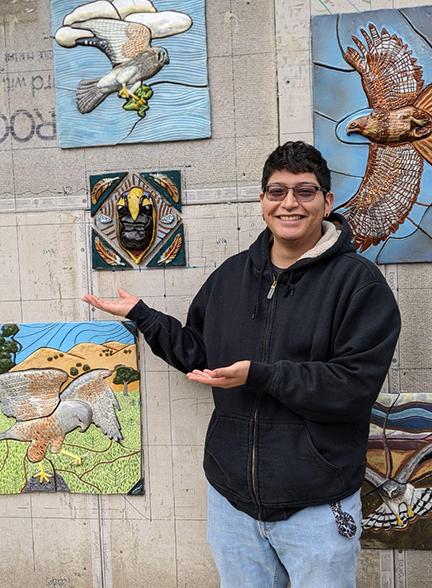
Jakob Lopez, an animal biology major, created the clear-winged grasshopper, Camnula pellucida,an California agricultural pest. “However, when I created this piece, I tried to focus on aspects involving the raptors, specifically American kestrels. This led me to create a sculpture showing an American kestrel beak coming out of the clay to eat a clear-winged grasshopper that lost its wings in the process. I then added 4 other pieces with kestrel feathers to center the piece. This reflects the key role insects have in raptor diets since they are heavy in nutrients and protein for their size, and knowing what their food source is can be extremely helpful in situations like tracing back the origin of a disease that is killing birds by the masses. This piece also reflects my stance on using insects as a food source because of their sustainability and nutritional value because this is already a common practice in places like Oaxaca Mexico (where my family is from). Overall, I believe this piece reflects the importance of raptor-insect interaction and helps the mural look more dynamic because of the complex idea.”
Cayden Monteiro, a biological systems engineering major, created two fiery skippers, Hylephila phyleus, sipping nectar from flowers. “I wanted to emphasize the difference between the male and female counterparts by showing the contrasting appearances of the two…I used lavender and deep purple underglazes to paint the flowers since many butterfly variants are attracted to vibrant colors. In creating each butterfly, I used a sculpting tool and a pin tool to shape the head, body, and proboscis. I used bits of extra clay to create the ‘spots' on its wings. For the flowers, I used a lot of scratching and sticking with water and a pin tool to prevent any air bubbles from being trapped under the clay. I made this piece to reflect on the benign nature of H. phyleus through a simple task such as consuming nutrients, while highlighting the beauty of something that will most likely go unnoticed.”
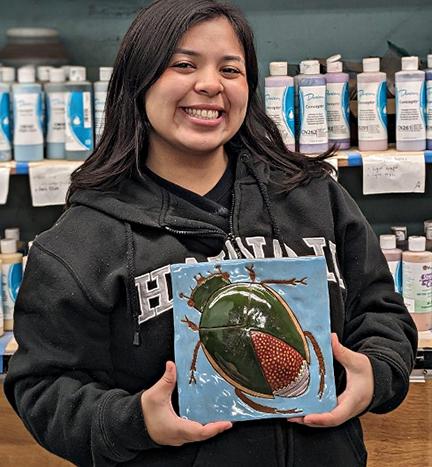
Ariana Sanchez, majoring in wildlife, fish and conservation biology, said her assigned insect was the figeater beetle, Cotinis mutabilis. “As stated in their name, these beetles' main food source revolves around soft-skinned fruit, especially figs. I wanted to emphasize their diet as it allowed me to incorporate all sorts of shapes and colors. In order to do this, I lifted the entirety of its body from the tile-shaped clay and continued to carve the inside of a fig in replacement of its abdomen, while still including its more natural components such as its elytra. The beetle's mouthparts and appendages were filled with grout to bring more texture to the overall piece. Underglazes help highlight the beauty of their elytra with different color sheens and accents within their one-inch bodies. Figeater beetles don't have a direct relationship with raptors, though with humans they aid in our compost piles during their larval stage. Other than this, they serve no other purposes other than to scare unexpecting encounters with their loud and uncoordinated flight caused by their half-opened elytra flight manner. These beetles are native to California and can frequently be found throughout early summer to early fall in any thin-skinned fruit-grown area. As intimidating as they can seem, they are no more than the hungry hippos of our insect world.”
Olivia Lucero, an animal science major on a pre-veterinary track, created the California mantis, Stagmomantis californica. The mantis, she wrote, “plays a vital role in ecosystem health as a natural predator” and “serves as a natural pest control in agricultural settings. To make my tile of the S. californica, I took a slab of clay and began my applique process by starting from the background and slowly adding each part from the back to the front to create depth. I have a connection to my piece because I had a pet California mantis, several years ago. By ‘raising' the mantis, I got to see how it hunts and watch it maneuver. I used a picture of my mantis as a reference and added a mealworm to show more aspects of the insect that somebody may not typically observe.”
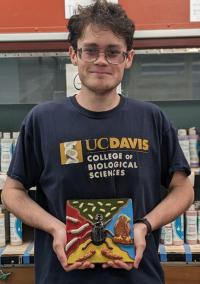
Hunter Barton, an animal science major who contributed the California sun beetle, Amara insignis, described it as a “seed-eating ground beetle found here on the west coast of the United States. They function as a primary consumer in the ecosystem by being an important food source for secondary consumers, most prominently birds which inadvertently also provides food sources for larger predators like raptors. I divided the piece into four quadrants with each piece describing a stage in their life that the viewer can follow in a circular order. The top depicts California sun beetles as eggs, the left shows them as larvae, the bottom as pupa, the middle beetle as a fully developed adult, and finally the right, showcasing a bird which consumes them, thus ending the cycle in order to begin again.”
Tias Ghosh, a computer engineering major, created the Edwards' glassy-wing moth, Pseudohemihyalea edwardsii. She described it as “an important source of food for raptors, in various stages of its life cycle. In my piece, the corners depict the different stages of the moth's life cycle. The oak branches and leaves bordering my tile represent the moth's habitat of oak trees and the caterpillar's diet of oak leaves. I painted my background blue to give the moth the illusion of being in the air and used the element of symmetry throughout the piece. I used emphasis by creating a border on the tile to draw focus to the large moth in the center of my piece. To recreate the hairs on the caterpillar and adult moth and the veins of the wings I used scraffito. I used natural clay, glaze, and sculpting tools to bring my insect to life. I hope viewers see the beauty in insects through my piece rather than focusing on the feeling of disgust or fear that many people associate with insects.”
Tongfei Li, an economics major, was assigned the little bear scarab beetle, Paracotalpa ursina. “For my art piece, I did very simple coloration. I made the thorax, the head, and the legs a mix color of brown and black. I made the abdomen deep green with pale white pigment on top of the green to create a fuzzy look. After the overall coloration, I made some small bar lines in yellow around the thorax and abdomen of P. ursina. As for the process, first I used the clay to create the shape of my insect, then I put on the coloration, and the underglaze as the last step. I left some space between the legs, head, thorax, and abdomen ofP. ursina on purpose because I wanted to show the art element of closure, and I did it in this way to make the structures ofP. ursinaclearer to see. P. ursina is important to the ecosystem because they eat lots of rotten food or rotten roots of the plants, they are the natural decomposers in the ecosystem.”
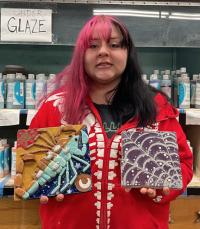
Cecelia Lopez, an English major, created the California common scorpion, Paruroctonus silvestrim, a native insect that fluoresces under ultraviolet light. “My tile is made of clay and underglaze. I started with the placement of the scorpion to be similar angle as the star sign. Scorpio, as well as using my grout lines to look like drawn pictures of the sun and moon in the sand…. Like many other insects, the California common scorpion has an incomplete metamorphosis meaning when they hatch from their egg, they go through many nymph stages (smaller versions of the adult)…the little white babies that look like ghosts in her back are her young…she takes care of (them) up until their exoskeleton hardens and they are able to survive alone…They can be found in almost every different habitat type and can easily camouflage to their surroundings. As a viewer. I want you all to see up close this scorpion that many are very intimidated by because of its painful but not deadly sting.”
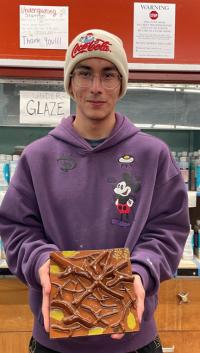
Julian Perez, a genetics and genomics major, contributed the Western short-horned walking stick, Parabacillus hersperus, a stick bug species commonly spelled "Western short-horned walkingstick." Perez, who noted he is from Los Angeles, said he doesn't "really see many bugs other than your typical flies and mosquitoes, so creating a walking stick was a little out of my comfort zone. However, for this project I knew that the stick bugs are most known for their camouflage, and like their name suggests. they look like sticks, so the idea of…camouflaging them…with surrounding sticks came into my head. The materials I used were clay and multiple colors of underglaze some of which include dark brown, a burnt orange, and some dull yellow. I used texture to create the groves of a stick and color to really try and hide the walking stick so it's not easy to find. I was also able to use the shapes of the sticks to almost imitate the legs of the walking stick so that the insect would be harder to find. The Western short-horned walkingstick is about 2-3.5 inches in length and has two short antennas on top of its head. They are also herbivores and so they naturally prune the foliage of the environment which promotes the growth of new plants and flowers.”
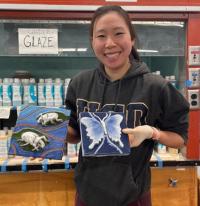
Lili Smith, majoring in environmental policy analysis and planning, created the Death Valley beetle, Ophryastes desertus. “My piece is a personified description of O. desertus made with clay, underglaze, and grout. I wanted to highlight the notable white exoskeleton of the weevil and contrast it against a dark green leaf. I employed the sgraffito technique to highlight the speckles in the exoskeleton of the weevil. I wanted to combine features such as asymmetry, perspective, and contrast to highlight this insect. O. desertus is a known pest that feeds on foliage, rotten wood, or bark and has been seen in gardens chewing on nuts and fruits. They play an important ecological role in pollination as well as decomposing. The insect poses no threat to humans, pets, or buildings. A fun fact about O. desertus is that they exhibit a unique behavior of playing dead by lying on their backs when disturbed. These insects are native to arid habitats that range across the United States and Canada. As a viewer, I hope you can enjoy the calm nature of the insect-eating its lunch as well as the contrasting body color to the dark leaf.”
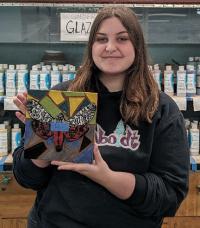
Jenny Baudizzon, an animal biology major, contributed the painted tiger moth, Arachnis picta, commonly found in the Southwestern United States. “They are known for their ability to camouflage with intricate marble patterning, as well as their mimicry in coloration to trick predators into thinking they're poisonous. These were the elements I focused on the most in my piece: the sheer contrast between the front vs. the hind wings. For the background, I made the top half bright, fun colors but the bottom half is very dark, almost eerie and I wanted the viewer to feel these emotions. I used grout lines to allow the incorporation of different colors in the background and to make a clear line between the contrasting halves. The moth itself is cut out of clay and laid on top of the background causing it to become the main focal point. I kept the marble pattern of the moth as accurate as I could when painting with the underglazes. The only exception was the toxic symbol I incorporated/hid within the pattern to explain why the moth is red on the bottom half.”
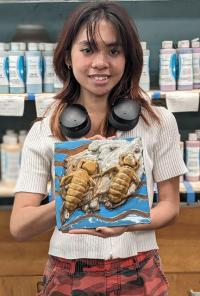
Kirstin Sioson, an English major, created a chewing louse, Degeeriella rufa. “This artwork offers a microscopic view of two female lice living amidst the feathers of a bird, specifically the prairie bird, where D. rufa is particularly found.” She highlighted the intricate details of their elongated abdomen and narrow heads, as well as their short yet robust legs. “This artwork also conveys how they interact with their avian host negatively, as they eat the feathers of their prairie bird, causing damage to their health during the winter, which also leads to the transmission of diseases and the bird's death…First, I formed the base with red clay and made the first layer as a teardrop structure of clustered feathers of their specific host, one by one using carving tools such as the pin tool, metal scraper, and a wooden modeling tool to make intricate details like the feather dents. Then I shaped the body of the two lice separately, modeling their structure according to their real-life counterparts, and sticking all the pieces together after molding the necessary parts. And then lastly, I used the colored underglazes to bring the piece to life with colors.”
Sunny Chang, a chemical engineering major, created the western forest scorpion Uroctonus mordax. “I enjoy studying isopods, and western forest scorpions just happen to eat them. Therefore, I chose to research forest scorpions and create a tile of them. The background of my tile consists of fake grout lines. The centerpiece of the tile consists of a giant forest scorpion carved from extra clay and attached to the base tile. The paint used for the work included white, orange, yellow, green, blue, and brown underglaze with three layers of clear glaze. I made this piece because forest scorpions look awesome when the sunlight reflects a bluish color on their exoskeleton. The wasps in the background add movement and depth while adding contrast around the scorpion to emphasize the focus on the scorpion. For some background information, the scorpion uses its stinger to land a final blow. Usually, scorpions have bad aim with their stingers; therefore, they rely on their pincers to grab onto prey before their stingers deal the final blow. In the clay tile, the scorpion demonstrates its pincer accuracy by killing wasps using. The viewer of the tile can infer that scorpions are excellent natural predators of pests. In the tile, the suburban area with barely any trees indicates their habitat loss. The tile contributes to the overall mural since scorpions are often preyed upon by raptors like owls.”
Ellie Hintzman, a mechanical engineering major, chose the bombardier beetle, Branchinus elongatulus, “a North and Central American species of beetle infamous for its noxious chemical spray. This beetle possesses a unique dual-sac on its abdomen, with one sac containing hydrogen peroxide and the other hydroquinone. When mixed, these two chemicals are ejected in a boiling, irritating spray to deter predators, which include insects, toads, and birds. The bombardier beetle is a unique insect important to the food chain. In this mural it can be found between mountains and desert among the grasslands, where it is preyed upon by the burrowing owl. In this design, I played on the name ‘bombardier beetle' to create a steampunk-inspired piece where the beetle itself is portrayed as a bomb. The explosive spray is seen as the burning fuse of a mechanical beetle-bomb. The beetle's eyes are reminiscent of the classic steampunk goggles, aiding to naturally infuse the steampunk style while retaining proper anatomy. As a mechanical engineering major with a zest for wordplay, this piece represents me as an engineer and a creativ,,,I hand-built this piece using red clay and glazed it with low-fire glazes before sending it to the kiln to be fired. The creative side of the process came together in one night with a sudden stroke of inspiration, which was then followed by several weeks of meticulous sculpting and glazing.”
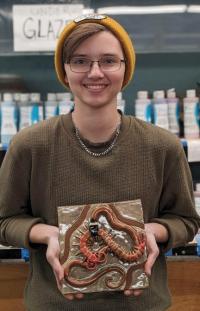
Oliver Smith, a first-year entomology major, created the tiger centipede, Scolopendra polymorpha. “I am very passionate about insects. I am especially interested in myriapods…S. polymorpha is a medium-sized desert centipede that preys on insects and small reptiles and is preyed upon by birds and larger reptiles. For my piece, I focused on the interactions between S. polymorpha and Tantilla cucullata, a small snake found in Texas. Both are mid-level predators and when prey is scarce they are in direct competition for survival. I represented this relationship by sculpting a S. polymorpha sinking its venomous mandibles into the snake's neck and a T. cucullata biting into the centipede's body; both locked in a deadly fight for survival. This was a rather ambitious project to sculpt, so I drew a plan and got critiques before working with clay. I positioned the snake and the centipede to be of equal emphasis because they have equally vital and competing roles in their environment. During sculpting I ran into some hurdles; the centipede's legs were too thin and breakable, so I followed TA (teaching assistant) Kirsten Sheehy's advice and created support structures underneath to reinforce them. Once I was done sculpting, I mixed underglazes to create specific shades and then overglazed the entirety for a shiny finish. As a viewer, I hope that you can see the vital competition between S. polymorpha and T. cucullate.”
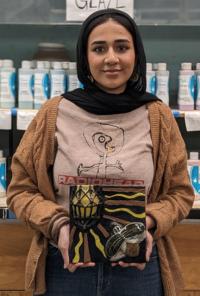
Mominna Raza, an animal biology major, contributed a ten-lined June beetle, Polyphylla decemlineata. Her piece shows the June beetle flying toward a light. “I'm passionate about organisms of every kind, insects included. This insect is found widely across North America and is incredibly influential to the lives and environments around it in both positive and negative ways. They are an important source of food for many animals, including birds like red-tailed hawks, and can make significant impacts on the plants that they feed on as well. The piece combined methods of sculpture and carving. The June beetle and light bulb were sculpted and applied onto the clay. The pieces were colored using underglazes that were both painted on and sgraffitoed through. The materials used were clay, underglaze, and grout. This piece is special to me because of my lifelong appreciation of June bugs. Oftentimes, June bugs are looked on as loud annoyances but I've always found them particularly interesting. I think insects in general are so misunderstood, especially those that dare to be more visible. My piece attempts to portray the overlap of insect lives within human dominated environments in a more positive light. The adult form of this insect is incredibly fleeting, with them living only a few short months in the form we see them most. I think that in such a short lifespan, such magnificent insects deserve to be celebrated in the light where they are seen.”
Ullman, a former chair of the entomology department and former associate dean for undergraduate academic programs, UC Davis College of Agricultural and Environmental Sciences, is a co-founder and co-director (with artist Donna Billick of Davis) of the UC Davis Art/Science Fusion Program, launched in September 2006. Her internationally acclaimed research involves insect/virus/plant interactions and insect-transmitted pathogens.
A Fellow of the American Association for the Advancement of Science (2014) and the Entomological Society of America (2011), Ullman was named the 2014 recipient of the ESA National Excellence in Teaching Award. She received the UC Davis Academic Senate's Teaching Award for Undergraduate Students in 2022.
Under her direction, Ullman and her colleagues have created dozens of art projects on the UC Davis campus and within the city of Davis. The mural, “The Secret Life of Vineyards,” with assistant professor Emily Meineke of the Department of Entomology and Nematology, was installed last August at the Matthiasson Winery, Napa. (See news story)
